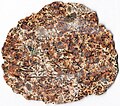English: (~6.5 centimeters across at its widest)
This is a slice from the Erg Chech 002 Meteorite, which was found in May 2020 on sand dunes of the Bir Ben Takoul area, western Algeria, northwestern Africa. It is a stony meteorite, the most common category (the others are irons and stony-irons). The two broad types of stony meteorites are chondrites, which have small rounded structures called chondrules, and achondrites, which have no chondrules - this meteorite is an achondrite. Many specific types of achondrites are known - most are from the Asteroid Belt. Asteroidal achondrites include angrites, aubrites, brachinites, ureilites, lodranites, acapulcoites, howardites, eucrites, diogenites, and the so-called winonaites (which may not be a meteorite type at all). Some planetary achondrites are also known - they come from the Moon (lunaites) or Mars (shergottites, nakhlites, and chassignites). The Erg Chech 002 Meteorites falls into none of these categories. Unclassifiable achondrites are referred to as "ungrouped". I'd prefer establishing names for distinctive types of ungrouped achondrites, but this has not been done.
Erg Chech 002 was originally described as a gabbro with pyroxene megacrysts. Gabbro is a mafic, phaneritic, intrusive igneous rock composed of plagioclase feldspar and pyroxene. Subsequent analysis has shown that Erg Chech 002 is a porphyritic andesite, an intermediate, extrusive igneous rock - in other words, a type of volcanic lava (it could also be from a near-surface intrusion). Andesite lavas and ash deposits are relatively common on Earth - they usually form from eruptions of subduction zone stratovolcanoes. Erg Chech 002 is not an Earth rock, so its lithology indicates the former presence of a differentiated parent body in the early Solar System that had surface volcanism of andesite. No known Solar System bodies have this, so the parent body has been disrupted (if so, probably by one or more impact events) or incorporated into a larger Solar System body.
Uncut and sliced samples of Erg Chech 002 show spectacular translucent green crystals (e.g., see: www.flickr.com/photos/jurvetson/51023828888 and
www.flickr.com/photos/jurvetson/51024557161 and
www.flickr.com/photos/jurvetson/50866150703 ). Prima facie, these look like olivine masses, but they're not. The large greenish-colored crystals and the long, dark blades in Erg Chech 002 are pyroxene phenocrysts (= large crystals in a porphyritic rock) (they've also been characterized as megacrysts and xenocrysts). The brownish-colored areas are iron oxide staining from weathering while on Earth.
The pyroxene content of Erg Chech 002 ranges from orthopyroxene to pigeonite to augite. The plagioclase feldspar component is oligoclase to albite, which are sodium-rich feldspars - this is unusual - most meteorites have calcium-rich feldspar. Minor reported minerals include potassium feldspar, chromite, ilmenite, troilite, cristobalite, tridymite, merrillite, FeNi metal, spinel, and a calcium phosphate mineral.
A dating study found that Erg Chech 002 is 4.565 billion years old.
An impact event ejected this rock from its parent body - shock metamorphism is present.
Synthesized from info. in:
2020. Meteoritical Bulletin 109.
Yamaguchi et al. (2021) - Petrology and geochemistry of Erg Chech 002, the oldest andesite in the Solar System. 52nd Lunar and Planetary Science Conference, no. 1892.
Chaussidon et al. (2021) - 26 Al chronology of Erg Chech 002, the oldest andesite in the Solar System. 52nd Lunar and Planetary Science Conference, no. 2222.

